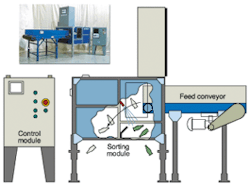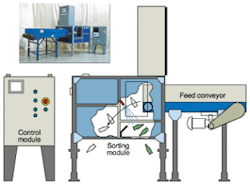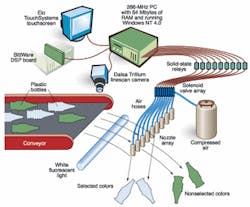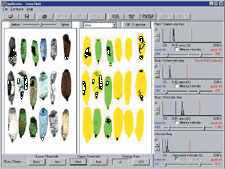Plastic-bottle sorter discerns variety of colors
Vision-based sorting system helps recyclers distinguish a spectrum of plastic-bottle colors using custom image-processing software.
By Jeff Child,Contributing Editor
In the past, most PET (polyethylene terephthalate) plastic beverage and water bottles were either clear or green. Bottle recyclers sorted these two colors with vision-based systems. Recently, an array of colored bottles has entered the market, a trend that started in Europe when light-blue tints were added to clear bottles of water. That expanded to more colors as vendors sought to tie distinctive colors to each of their product brands.
FIGURE 1. MultiSortES color-sorting system performs color spectrum analyses to determine specific color using a high-speed, high-accuracy color sensor system and a computer that processes identification algorithms (top). Multiple spectral determinations of color are made for each bottle within a feed stream of bottles moving through the sorting system (bottom). Bottles to be sorted are fed into the system on a conveyor belt of 40 inches in width and moving at a speed of 10 ft/s. As the bottles leave the end of the conveyor, they pass between a strip light source and an overhead camera for color selection
Now, in the United States, plastic-bottle manufacturers are also gearing up to take advantage of the marketing edge inherent in using a spectrum of colors. Moreover, major beer companies are considering the introduction of amber-colored bottles, and soft-drink makers are pondering bottle colors including different shades of green, purple, and yellow. While the wider color choice is good for bottled-drink marketers, it poses new challenges and increased costs to plastic-bottle recyclers who must segregate the different colors.
To handle this widening array of colors, plastic-bottle recyclers need improved automated color-sorting technology. Such technology must not only handle a wide spectrum of colors, but must also offer easy programmability. These techniques would enable recyclers to expand or change color-sorting targets as new colors are introduced into the marketplace or as various mixtures of plastic colored bottles arrive at the recycler's plant.
System integrators at National Recovery Technologies Inc. (NRT; Nashville, TN) have tackled this problem by crafting its MultiSort ES (extended spectrum) color-sorting vision system. At the core of the problem are color-filtering issues. Most automated color sorters installed for discerning plastic bottles can distinguish only green bottles from clear bottles. Such systems rely on color-filtering technology to image the bottles for sorting through a red filter. Accordingly, clear bottle images appear bright and green bottle images appear dark. Red filters are used because green has very little red in its spectrum.
However, adding blue-green bottles to the mix complicates the sorting process. When using red-filter systems, recyclers can sort green PET and blue-green PET bottles from clear PET bottles, but cannot distinguish the two green-based plastics from each other. Green PET can be distinguished from clear PET and from blue-green PET using a blue spectral filtering approach. However, blue-green PET cannot be distinguished from clear PET using this approach.
FIGURE 2. As colored plastic bottles pass between the light source and overhead camera, light passes through the bottles and is sensed by the camera. The system computer analyzes the camera data and determines the color and position of bottles coming off the end of the conveyor. Selected colored bottles are separated from the non-selected bottles by a blast of compressed air from one or more air nozzles, as determined by the computer. These nozzles are positioned in an array located a few inches above the feed stream of bottles. This setup maintains the elapsed time from detection to ejection at 50 ms or less. Nonselected bottles cascade over the array, fall onto another conveyor belt, and exit the sorting system.
Furthermore, none of the approaches is effective for sorting clear bottles from among an array of other colors, which in today's recycling environment includes light blue, medium blue, dark blue, violet, amber, light green, blue-green, aqua, red, and yellow, among others. Moreover, traditional color-vision approaches cannot sort bottles in this array of colors from each another.
SPECTRUM OF COLORSTo handle the wide range of colors in use today, a novel color-sorting technology is applied that can distinguish among many different colors and even between subtle differences in the same color. NRT engineers used this technology in its MultiSort ES color-sorting system (see Fig. 1).The MultiSort ES system performs color spectrum analyses to determine exact colors using a high-speed, high-accuracy color sensor and rapid computerized identification algorithms. It makes multiple spectral determinations of color for every bottle within a feed stream of bottles moving through the sorting system. These spectral readings are correlated to determine an accurate color for each bottle. More than 3 million sensor readings are analyzed per second in a typical application. Moreover, an array of color values can be user-selected and identified for the system to accept or reject plastic colored bottles.
Because a typical PET bottle weighs a tenth of a pound, a large number of bottles must be processed to accumulate a ton of recycled plastic. Bottles to be sorted are fed into the system on a 1-m-wide conveyor belt moving at a speed of 10 ft/s (3 m/s). As the plastic bottles leave the end of the conveyor, they pass between a strip-light source and an overhead camera. The light source, a wide-spectrum white fluorescent light, is positioned so that it runs parallel to the end of the conveyor belt and slightly below the end of the conveyor so that the overhead color camera has a clear view of the light strip (see Fig. 2).
The camera used in the MultiSort ES system is a three-CCD RGB linescan camera available from several companies, such as the Trillium camera from Dalsa Inc. (Waterloo, Ontario, Canada), for example. The camera is positioned in a separate housing above the conveyor so that the scan of the camera views a strip of width equal to the width of the conveyor belt and located just off the end of the conveyor. This vision system typically operates at a rate of 500 to 1000 lines/s with a line resolution of 512 to 2048 pixels. These parameters are user-selected for a particular application.
FIGURE 3. The user of the MultiSortES system operates a graphical interface that incorporates touch-screen slider buttons for selecting the eject ranges of color functions derived from images received from the vision system. Each selection window shows the distribution in values of that color function derived for an area within a rectangle selected by the user on a true color bottle image on the left side of the screen. The left side shows the bottles in true color as the camera sees them. The center portion of the image shows the bottles' images in false color after processing through the sorting algorithm. The sorting algorithm for ejection does not select yellow false-colored bottles. The algorithm for ejection selects the green false-colored bottles. Black areas represent labels, caps, and base cups.
As the plastic bottles pass between the light strip and overhead camera, the camera senses light transmitted through the bottles. The camera passes its imaging data to a computer housed in a freestanding control module. The computing system analyzes the camera data and determines the color and position of the bottles coming off the end of the conveyor.
Selected bottles are separated from the nonselected bottles by a blast of compressed air from one or more air nozzles. These nozzles are placed in an array that is located a few inches above the position where the bottle color is detected. As a result, the time from detection to selection is typically less than 50 ms. Bottles that are not ejected cascade over the conveyor and fall onto a take-out conveyor and exit the color-sorting system.
Across the width of the belt, NRT integrators chose to use one air nozzle per inch of belt width. More or fewer nozzles can be used, with the choice being a trade-off between hardware cost and required performance. For example, if large plastic bottles or other objects are being sorted, the nozzle spacing can be wider, whereas smaller bottles necessitate closer spacing. All nozzles are individually controlled, so separate detection and selection tasks occur simultaneously across the width of the in-feed conveyor.
Vision processing is performed on a BittWare (Concord, NH) digital-signal-processing (DSP) board sporting an Analog Devices (Wilmington, MA) SHARC DSP chip. The Bittware board resides in the backplane of an off-the-shelf industrial-type 266-MHz PC, located in a separate freestanding control module. The PC provides 64 Mbytes of DRAM and runs the Microsoft (Redmond, WA) Windows NT 4.0 operating system. However, NRT engineers developed their own software to manage parameter entry, provide operating data, and control system operating and monitoring functions.
The user operates the MultiSort ES system via a touchscreen monitor from Elo TouchSystems (Fremont, CA). The interface software lets the user define and select colors to be removed from the plastic-bottle mixture. A split screen shows a "snapshot" of actual bottles on one side. The other side presents a false-color image of the bottles currently selected for removal (see Fig. 3).
NRT engineers chose Windows NT as the operating system platform because of its familiarity to most users. The system's user interface software provides data output for user evaluation and includes routines for system set-up, diagnostics, and trouble-shooting. A Snapshot Utility feature lets the user capture digital images of the moving bottles. Then, the user can analyze the images through the touch-screen monitor by setting particular operating parameters for the sorting algorithm, depending upon which selected bottles the user wants to eject from the stream. More importantly, this feature frees a non-skilled user from having to rely upon technical personnel for setting sorting parameters.
HOW IT WORKSThe user selects the range of colors to be ejected via a graphical interface that incorporates touchscreen slide buttons. These buttons are adjusted to determine the eject ranges of the color functions derived from imaging data received from the camera. Each selection window shows the distribution in values of that color function derived for an area within a rectangle selected by the user on a true color bottle image, located on the left side of the screen. The user can adjust the sorting algorithm so that it selects only the color within the selected rectangle by bracketing the color distributions closely between the lower threshold and the upper threshold for three distributions. These settings are then applied to all bottles within the images.Any areas of color within the image whose three distributions fall within the upper and lower threshold brackets are selected for ejection. Those areas are colored green in the false-colored image. Areas where any of the three distributions fall outside the brackets are not selected for ejection. These areas are colored yellow in the false-colored image. The results of the settings show up instantly on the snapshot screen as the user makes changes.
This process lets the user see the setting results before saving the settings to be used in the sorting process. After the user has selected the color range of the plastic bottles to be ejected, this information can be written to the sorting program through the Threshold Manager button located at the upper portion of the screen. Therefore, the user does not need to enter parameter numbers into the program because they are automatically entered through the Threshold Manager.
The Snapshot Utility also allows imaging snapshots to be saved under user-selected file names and recalled for review and analysis. The user can derive settings for certain types of bottle feed-streams and can store these settings along with the snapshot images. Then, when the same type of feed-stream, say from a particular storage region, is needed in the system, the user can recall the parameter settings and set them into the sorting software without having to reanalyze the image data.
Company InformationAnalog DevicesNorwood, MA 02062Web: www.analog.comBittWare Inc.
Concord, MA 03301
Web: www.bittware.com
Dalsa Inc.
Waterloo, ON, Canada N2V 2E9
Web: www.dalsa.com
Elo TouchSystems Inc.
Fremont, CA 94555
Web: www.elotouch.com
Microsoft Corp.
Redmond, WA 98052
Web: www.microsoft.com
National Recovery Technologies Inc.
Nashville, TN 37228
Web: www.nrt-inc.com



